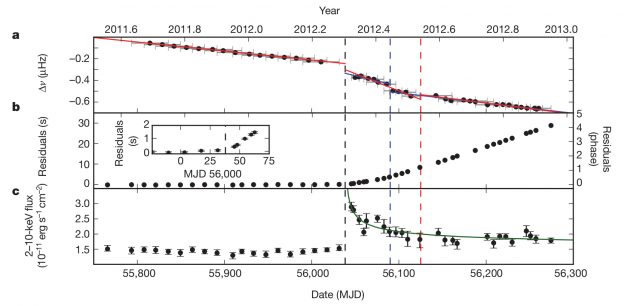The spinning down magnetar

Todays story seems fairly simple: a magnetar has been seen spinning down. Impressive, isn’t it? You might be wondering what the hell is magnetar and why we should care about its spin. As it happens many times in science, we find nature behaving just the opposite to what we supposed it should. For scientists, this is not only fascinating, it is the only way to truly understand things that are far beyond our sight. Let’s try to shed some light over this.
A magnetar is a kind of neutron star. This means a corpse, a star corpse. We say that a star is dead when it is no longer able to sustain nuclear fusion in its interior and therefore it is just cooling slowly without producing any new energy. This kind of object comes from a star massive enough to leave behind a core of degenerated matter, but not enough to create a black hole. Neutron stars are supposed to be formed during cataclysmic events known as supernovae, and they survive only because of Quantum Physics and Pauli’s exclusion principle. In short, this quantum principle implies a degeneracy pressure which prevents the star collapse in spite of its huge density. In other words, neutrons cannot be more densely packed than in a neutron star, which is the equivalent of compressing the mass of the Sun into a 20 km sphere.
Not all neutron stars look the same, though. Some of them have periodic X-ray and soft gamma-ray bursts. In the 90s, it was hypothesized that neutron stars with strong magnetic fields would show that kind of emissions 1. This type of neutron star was dubbed a magnetar. This allowed to explain some anomalous emissions observed back in 1979. So far, just a dozen of magnetars are known so this is truly an exotic kind of star.
In a News & Views for Nature magazine 2, Robert Duncan summarized the main properties of a magnetar. Being neutron stars, they are supposed to have 1km thick crust mainly formed by a lattice of crystal iron. This iron becomes more and more neutron rich as one goes deeper into the star. Below the crust, an ocean of pure nuclear fluid is expected, some “200 trillion times denser than liquid water”, as Duncan points out. The central core is possibly just a soup elementary particles.
Obviously, we cannot peek into neutron stars, even though this would give us a tremendous insight into some current unknowns of particle physics. But we can gain some insight by studying their emissions. All known neutron stars have a steady spin down, punctuated by what is called ‘glitches’ when the neutron star suddenly accelerates. This is known to be produced by an imperfect coupling between interfaces in the neutron star’s interior.

However, this year an anomalous phenomenon has been reported for the magnetar 1E 2259+586 3, a neutron star spinning once every 7s approximately. This has been the first ‘anti-glitch’ ever seen, after which the magnetar suddenly braked. This event was followed by a second one which could have been either a glitch or anti-glitch depending on which model you relay to explain the observations.

This could have happened because something outside the magnetar took some of its angular momentum. This angular momentum transfer could be due to an outflow along open field lines or by a sudden twist of these lines. However, observations of the double event do not favor this hypothesis. Instead, it seems more easy to conciliate with observations a rotation change due to intrinsic reasons. This means an angular momentum transfer between the crust and the superfluid ocean as in a normal glitch. But, this time, it happened just in the opposite direction to what always observed and expected.
The observation of the anti-glitch is so unexpected that the authors state that it “indicates the need for a rethinking of glitch theory for all neutron stars”. In particular, R. Duncan points that this supports the idea of the magnetar crust not being massive enough to provoke the glitches through the commonly assumed process of angular momentum transfer. In other words, this implies a more complex internal structure for neutron stars than was previously assumed. There is still a long way to go to fully address the physics of such an exotic object but the observations reported by Archibald and collaborators open an exciting new path in their understanding.
References
- R.C. Duncan and C. Thompson (1992). Formation of very strongly magnetized neutron stars: implications for Gamma Ray Bursts. The Astrophysical Journal, 392, L9 – L13. d.o.i.: 10.1086/186413 ↩
- R.C. Duncan (2013). A glimpse inside a magnetar. Nature, 497, 574 – 575 doi:10.1038/497574a. ↩
- Archibald R.F., Kaspi V.M., Ng C.Y., Gourgouliatos K.N., Tsang D., Scholz P., Beardmore A.P., Gehrels N. & Kennea J.A. (2013). An anti-glitch in a magnetar, Nature, 497 (7451) 591-593. DOI: 10.1038/nature12159 ↩